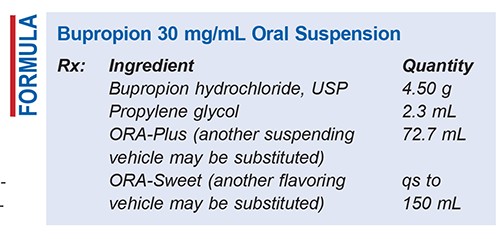US Pharm. 2023;48(10):58-59.

Method of Preparation: Calculate the quantity of bupropion hydrochloride (HCl) needed for the total amount to be prepared. Accurately weigh or measure each component. Combine the bupropion HCl with a small volume of propylene glycol (PG) to achieve a homogeneous paste. Geometrically, incorporate the ORA-Plus (or preferred suspending agent), mixing thoroughly after each addition. Introduce an adequate quantity of ORA-Sweet (or preferred flavoring vehicle) to attain the final volume, being sure to mix thoroughly. Alternatively, ORA-Blend (a blend of ORA-Plus and ORA-Sweet) may be used as the vehicle. Shake the mixture thoroughly, package, and label.
Use: Bupropion oral suspension may used for treatment of depression, attention-deficit/hyperactivity disorder (ADHD), bipolar disorder, seasonal affective disorder, and smoking cessation. The oral suspension is suitable for patients who have difficulty swallowing pills or require a titrated dosage because the available dosage does not fit their needs.
Packaging: Package in a tight, light-resistant container.
Labeling: Keep out of reach of children. Keep refrigerated. Protect from light. Shake well. Discard after ____ [time period].
Stability: The USP default beyond-use date for nonpreserved aqueous oral liquids is 14 days when stored in a refrigerator.1
Quality Control: Weight/volume, pH, specific gravity (SG), active drug assay, color, rheologic properties/pourability, physical observation, and physical stability (discoloration, foreign materials, gas formation, mold growth) are all examples of quality-control assessments.2
Discussion: Bupropion HCl (Wellbutrin, C13H18ClNO • HCl, MW 276.2) is an antidepressant of the aminoketone class. It is approved for the treatment of adult depression, seasonal affective disorder, and smoking cessation and is also used off-label for conditions such as ADHD, depression associated with bipolar disorder, and obesity. Although its exact neurochemical mechanism remains unclear, bupropion exhibits relatively weak inhibition of norepinephrine and dopamine reuptake without affecting monoamine oxidase or serotonin reuptake. Bupropion is a racemic mixture, with therapeutic effects typically manifesting during the second week of treatment. Peak serum concentration is reached approximately 2 hours after administration of an immediate-release (IR) dose, and the duration of action is 1 to 2 days. Potential side effects include headaches, agitation, weight loss, constipation, dry mouth, tremors, and blurred vision. Patients should be monitored appropriately and closely observed for clinical worsening, suicidality, or unusual changes in behavior.3,4
Bupropion HCl is a white, crystalline powder that is highly soluble in water. It has a bitter taste and can induce a localized numbing sensation on the oral mucosa. Bupropion tablets are available in both IR and extended-release formulations. The IR tablets are available in strengths of 75 mg and 100 mg, with inactive ingredients including hydroxypropyl cellulose, hypromellose, microcrystalline cellulose, PG, talc, and titanium dioxide.3,4
PG (C3H8O2) is a clear, colorless, odorless, viscous liquid with a sweet, glycerin-like taste. PG is miscible with acetone, chloroform, 95% ethanol, glycerin, and water; it is not miscible with fixed oils or light mineral oil. PG acts as a humectant in topicals; a preservative in solutions and semisolids; and a solvent or cosolvent in aerosols, oral solutions, parenterals, and topicals. PG has an SG of 1.038 g/mL, and it may be used to carry flavors and emulsifiers. It is stable and may be mixed with other solvents. Because PG is hygroscopic, it should be stored in an airtight container and protected from light.5
ORA-Plus is an oral suspending liquid that exhibits thixotropic behavior. It can be diluted with up to 50% or more of water, flavorings, or syrups without losing its suspending properties. At 25°C, ORA-Plus has a viscosity of approximately 1,000 cps, a pH of around 4.2, and an osmolality of 230 mOsm/kg. Its ingredients include purified water, microcrystalline cellulose, sodium carboxymethylcellulose, xanthan gum, carrageenan, sodium phosphate, citric acid, and simethicone as antifoaming agents, and potassium sorbate and methylparaben as preservatives.6
ORA-Sweet is an oral syrup vehicle typically used to mask the taste of bitter medications. ORA-Sweet has a pH of approximately 4.2, and its osmolality is around 3,450 mOsm/kg. Its ingredients include purified water, sucrose, glycerin, sorbitol, flavorings, sodium phosphate, and citric acid as buffering agents, and potassium sorbate and methylparaben as preservatives.7
REFERENCES
1. U.S. Pharmacopeia/National Formulary [current revision]. Rockville, MD: U.S. Pharmacopeial Convention, Inc; September 2022.
2. Allen LV Jr. Standard operating procedure for performing physical quality assessment of oral and topical liquids. IJPC. 1999;3:146-147.
3. Wellbutrin (bupropion hydrochloride) product information. Research Triangle Park, NC: GlaxoSmithKline; May 2017.
4. O’Neil MJ. Bupropion hydrochloride. The Merck Index. 13th ed. Whitehouse Station, NJ: Merck & Co, Inc; 2001:252.
5. Weller PJ. Propylene glycol. In: Rowe RC, Sheskey PJ, Quinn ME, eds. Handbook of Pharmaceutical Excipients. 6th ed. London, England: Pharmaceutical Press; 2009:592-594.
6. ORA-Plus product information. Minneapolis, MN: Padagis LLC; 2022.
7. ORA-Sweet product information. Minneapolis, MN: Padagis LLC; 2022.
The content contained in this article is for informational purposes only. The content is not intended to be a substitute for professional advice. Reliance on any information provided in this article is solely at your own risk.
To comment on this article, contact rdavidson@uspharmacist.com.





